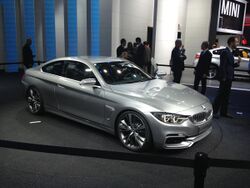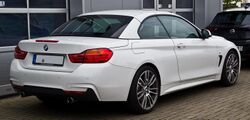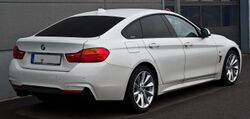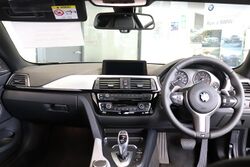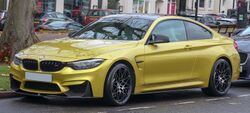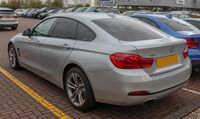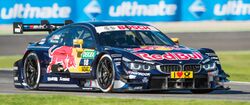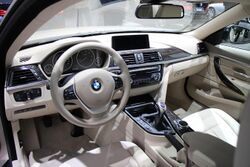BMW 4 Series (F32)
Topic: Engineering
 From HandWiki - Reading time: 10 min
From HandWiki - Reading time: 10 min
| BMW 4 Series (F32/F33/F36) | |
|---|---|
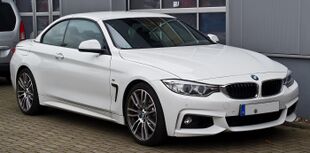 | |
| Overview | |
| Manufacturer | BMW |
| Production | July 2013 – present |
| Assembly |
|
| Designer | |
| Body and chassis | |
| Class | Compact executive car (D) |
| Body style | |
| Layout | Front-engine, rear-wheel-drive / all-wheel-drive (xDrive) |
| Related | |
| Powertrain | |
| Engine | |
| Dimensions | |
| Wheelbase | 2,810 mm (110.6 in) |
| Length | 4,638 mm (182.6 in) |
| Width | 1,825 mm (71.9 in) |
| Height |
|
| |uk|Kerb|Curb}} weight | 1,430–1,850 kg (3,153–4,079 lb) |
| Chronology | |
| Predecessor | BMW 3 Series (E90) |
| Successor | BMW 4 Series (G22) |
The first generation of the BMW 4 Series consists of the BMW F32 (coupé version), BMW F33 (convertible version) and BMW F36 (four-door coupé version, marketed as 'Gran Coupé') compact executive cars. The F32/F33/F36 has been produced since 2014 and is often collectively referred to as the F32.
The F32 was introduced as the successor to the E92/E93 coupé/convertible models of the fifth-generation 3 Series range. The F32 is produced alongside - and shares many features with - the F30 3 Series. As with the F30 3 Series range, the F32/F33/F36 is powered by turbocharged petrol and diesel engines with 3 cylinders (petrol only), 4 cylinders, and 6 cylinders.
The high performance F82/F83 M4 models were introduced in early 2014.[3] They are powered by the S55 turbocharged straight-six engine.
Development and launch
Official details of the "Concept 4 Series" were released in December 2012, detailing the intention to replace the E92 3 Series coupé with a new 4 Series line.[4][5]
In 2013, the concept vehicle (called the Concept 4 Series Coupé)[6] was unveiled at the North American International Auto Show.[7][8]
Compared with its E92 predecessor, the F32's wheelbase is 50 mm (2.0 in) longer, the overall length is increased by 31 mm (1.2 in) and the width is increased by 44 mm (1.7 in).[9] The front track width is 1,545 mm (60.8 in) and the rear track width is 1,593 mm (62.7 in), increases of 45 mm (1.8 in) and 80 mm (3.1 in) respectively.
Body styles
Coupé (F32)
The coupé models were unveiled in September 2013 at the Frankfurt Motor Show.[10] The launch models consisted of the petrol 428i and 435i, and the diesel 420d.[11]
In the remainder of 2013, the following models were added: 420i, 420d, 425d, 430d and 435d.[12][13] In 2014, the 418d model was added.[14] Most models were available with all-wheel drive ("xDrive").
Convertible (F33)
The convertible body style was unveiled at the 2013 Tokyo Motor Show,[15] followed by the 2013 LA Auto Show.[16]
Its international launch was in Las Vegas in January 2014.[17] The launch models were the petrol-engined 428i and 435i, and the diesel 420d.[18] All-wheel drive (xDrive) became available a few months after the launch.[19]
Gran Coupé (F36)
The 4 Series Gran Coupé was unveiled at the 2014 Geneva Motor Show,[20] followed by 2014 New York International Auto Show[20] and the 13th Beijing International Automotive Exhibition in 2014.[21] Production of the Gran Coupé began in the Dingolfing plant in July 2014.[22][23]
As per the larger 6 Series Gran Coupé (F06), the F36 has coupé styling with a fastback rear. However, the F36 also includes a C-pillar located behind the rear doors. Compared with the F30 sedan, the F36 has 13 mm (0.5 in) less rear headroom and the same cargo volume. With the rear seats folded down, the F36 has a cargo volume of 1,300 L (45.9 cu ft).[24]
The launch models were the petrol-engined 420i, 428i and 435i, and the diesel 418d and 420d.[25][26] The 435i Gran Coupé is approximately 91 kg (200 lb) heavier than the equivalent F30 335i sedan.[27]
Facelift
On the 16 January 2017 , BMW debuted its latest facelift, or LCI (Life Cycle Impulse), for the BMW 4 Series.
Equipment
Available equipment includes a head-up display, 8-speed automatic transmission and LED headlights.[28]
Optional "BMW M Performance Parts" were unveiled at the 2013 Frankfurt Motor Show.[29] The available upgrades included exhausts, power upgrades, bodykit, limited slip differential, steering wheels and interior trims.[30][31]
Engines
Petrol engines
| Model | Years | Engine | Power | Torque | 0-100 km/h (62 mph) |
|---|---|---|---|---|---|
| 418i | 2016– | B38A15M0 1.5 L turbocharged I3 |
100 kW (136 PS; 134 hp) at 4,400–6,000 rpm | 220 N⋅m (162 ft⋅lb) at 1,250–4,300 rpm | 9.6 seconds |
| 420i | 2014–2016 | N20B20 2.0 L turbocharged I4 |
135 kW (184 PS; 181 hp) at 5,000–6,250 rpm | 270 N⋅m (199 ft⋅lb) at 1,250–4,500 rpm | 7.3 seconds |
| 2016– | B48B20A 2.0 L turbocharged I4 |
135 kW (184 PS; 181 hp) at 5,000–6,500 rpm | 270 N⋅m (199 ft⋅lb) at 1,350–4,600 rpm | 7.5 seconds | |
| 428i | 2013–2016 | N20B20 2.0 L turbo I4 |
180 kW (245 PS; 241 hp) at 5,000–6,000 rpm | 350 N⋅m (258 ft⋅lb) at 1,250–4,800 rpm | 5.8 seconds |
| 430i | 2016– | B48B20B 2.0 L turbocharged I4 |
185 kW (252 PS; 248 hp) at 5,250–6,500 rpm | 350 N⋅m (258 ft⋅lb) at 1,450–4,800 rpm | |
| 435i | 2013–2016 | N55B30M0 3.0 L turbocharged I6 |
225 kW (306 PS; 302 hp) at 5,800–6,500 rpm | 400 N⋅m (295 ft⋅lb) at 1,200–5,000 rpm | 5.1 seconds |
| 440i | 2016– | B58B30M0 3.0 L turbocharged I6 |
240 kW (326 PS; 322 hp) at 5,500–6,500 rpm | 450 N⋅m (332 ft⋅lb) at 1,380–5,000 rpm | 4.5 seconds |
| M4 | 2013– | S55B30T0 3.0 L twin-turbocharged I6 |
317 kW (431 PS; 425 hp) at 5,600–7,300 rpm | 550 N⋅m (406 ft⋅lb) at 1,800–5,500 rpm | 4.1 seconds |
| M4 Comp[32] | 2016– | 331 kW (450 PS; 444 hp) at 7,000 rpm | 4.0 seconds | ||
| M4 CS | 2017– | 338 kW (460 PS; 453 hp) at 6,250–7,000 rpm | 600 N⋅m (443 ft⋅lb) at 4,000–5,380 rpm | 3.9 seconds | |
| M4 GTS[33] | 2016– | 368 kW (500 PS; 493 hp) at 6,250 rpm | 600 N⋅m (443 ft⋅lb) at 4,000–5,000 rpm | 3.8 seconds |
Diesel engines
| Model | Years | Engine | Power | Torque | 0-100 km/h (62 mph) |
|---|---|---|---|---|---|
| 418d | 2014–2019 | N47D20 2.0 L turbocharged I4 |
105 kW (143 PS; 141 hp) at 4,000 rpm | 300 N⋅m (221 ft⋅lb) at 1,750–3,000 rpm | 8.6 seconds |
| 2015– | B47D20 2.0 L turbocharged I4 |
110 kW (150 PS; 148 hp) at 4,000 rpm | 320 N⋅m (236 ft⋅lb) at 1,500–3,000 rpm | ||
| 420d | 2013–2015 | N47D20 2.0 L turbocharged I4 |
135 kW (184 PS; 181 hp) at 4,000 rpm | 380 N⋅m (280 ft⋅lb) at 1,750–2,750 rpm | 7.3 seconds |
| 2015– | B47D20 2.0 L turbocharged I4 |
140 kW (190 PS; 188 hp) at 4,000 rpm | 400 N⋅m (295 ft⋅lb) at 1,750–2,500 rpm | 7.1 seconds | |
| 425d[34] | 2014–2016 | N47D20O1 2.0 L twin-turbocharged I4 |
160 kW (218 PS; 215 hp) at 4,400 rpm | 450 N⋅m (332 ft⋅lb) at 1,500–2,500 rpm | 6.5 seconds |
| 2016– | B47D20O1 2.0 L twin-turbocharged I4 |
165 kW (224 PS; 221 hp) at 4,400 rpm | 450 N⋅m (332 ft⋅lb) at 1,500–3,000 rpm | 6.1 seconds | |
| 430d | 2014– | N57D30O1 3.0 L turbocharged I6 |
190 kW (258 PS; 255 hp) at 4,000 rpm | 560 N⋅m (413 ft⋅lb) at 2,000–2,750 rpm | 5.5 seconds |
| 435d xDrive | 2014– | N57D30T1 3.0 L twin-turbocharged I6 |
230 kW (313 PS; 308 hp) at 4,400 rpm | 630 N⋅m (465 ft⋅lb) at 1,500–2,500 rpm | 4.7 seconds |
M4 version
Up until 2014, BMW M models used the same model codes as the rest of the model range. However, the F32/F33/F36 generation was one of the first where the M models use separate model codes: F82 for the coupé and F83 for the convertible.[35]
The F82/F83 M4 is powered by the S55 twin-turbocharged straight-6 engine rated at 431 PS (317 kW; 425 hp) and 550 N⋅m (406 lb⋅ft).[36] The gearbox is either a 6-speed manual (with throttle blip on downshifts) or a 7-speed dual clutch transmission (M-DCT).[37]
The M4 also features an electronically controlled limited-slip differential, electric steering,[35] additional bolted joints between the axle subframe and the body sills, aluminium stiffening plate and a five-link rear suspension constructed from aluminium Carbon-fibre is used for the roof, bootlid, strut brace and driveshaft.[35][38][39] Unusually, the suspension subframes are directly connected to the chassis without rubber bushings.[36] An optional head-up display comes with additional M-specific functions such as a gear display, rev counter and Optimum Shift Indicator.[40]
M4 Coupé (F82)
The Concept M4 Coupé was unveiled at the 2013 Pebble Beach Concours d'Elegance,[41][42] followed by the 2013 Tokyo Motor Show.[15] The production version was then unveiled at the 2014 North American International Auto Show,[43] followed by 13th Beijing International Automotive Exhibition 2014.[21]
M4 Convertible (F83)
The convertible model was unveiled at the 2014 New York International Auto Show,[20] followed by 22nd Auto Mobil International Leipzig 2014.[44] Features include a three-part folding metal hardtop with noise-absorbing headliner and air curtains. A wind deflector and neck warmers were available as options.
Model year changes
2016
- Limited Edition 435i ZHP Coupé model released in the USA.[45]
- Engines upgraded, along with F30 3 Series LCI models.
- 440i model replaces the 435i, and 430i model replaces the 428i
- 425d model introduced[46]
2017 facelift
The facelifted (LCI) models of the BMW 4 Series were unveiled in January 2017[47][48], with the first pictures of the refreshed Coupé (F32 LCI) shown in the new color Snapper Rocks Blue (turquoise blue), and the Convertible (F33 LCI) shown in the also new, Sunset Orange colour (bright orange). The Gran Coupé (F36 LCI) model was shown in a silver colour.
The facelift (LCI) was introduced for the 2018 model year.[49][50] Major changes include:
- Exterior design changes including redesigned LED headlights, tail-lights, and bumpers[51]
- Interior design changes including an updated iDrive system (version 6.0)[52]
- Revised stiffer suspension on Coupé and Gran Coupé models[53]
- New additional trim, wheel, and exterior colour options[54]
Motorsport
M4 DTM Touring Car
The M4 DTM was developed in 2013 to replace the E92 M3 DTM, has been raced in DTM from 2014 to the present. It was designed by BMW chief engineer Dominic Harlow and unveiled in official ITR tests in Budapest.[55][56] The M4 DTM replaced the retired BMW M3 DTM at the end of the 2013 season.
In its debut 2014 season, Marco Wittmann won the Drivers' Championship in the M4 and Team RMG won the Teams' Championship.[57] In the 2016 season, Marco Wittman again won the Drivers' Championship in the M4.[58]
M4 DTM Safety Car
The M4 was used as a safety car at DTM races from 2014–present.[59][60] The M4 DTM Safety Car features Recaro racing seats, a roll bar, bonnet with "motorsport lock", LED lights on the roof and LED lights on the front apron.[61]
M4 MotoGP Safety Car
The M4 was used as a safety car at MotoGP races from 2014–present. The car was unveiled at the 2014 Qatar motorcycle Grand Prix.[62][63] It features Recaro racing seats , a roll bar, bonnet with motorsport lock, LED lights at roof and front apron, main electricity switch at bonnet, removal of the rear seat, fuel pump system, a fire extinguisher and a race display on the steering wheel.
Production volumes
The F32 coupé and F82 M4 coupé are produced in Munich,[64][65] with production beginning in July 2013. The F33 convertible is produced in Regensburg, beginning in November 2013.[23][66] The F36 Gran Coupé is produced in Dingolfing.[67][68]
The following are production figures for the 4 Series range:[69]
| Year | Production |
|---|---|
| 2013 | 14,763 |
| 2014 | 119,580 |
| 2015 | 152,390 |
| 2016 | 133,272 |
| 2017 | 133,104 |
| 2018 | 109,887 |
| Total: | 662,996 |
References
- ↑ "BMW Concept 4 Series vs. BMW 4 Series Coupe Production – Photo Comparison". http://www.bmwblog.com/2013/06/17/bmw-concept-4-series-vs-bmw-4-series-coupe-production-photo-comparison/. Retrieved 30 April 2017.
- ↑ cn.linkedin.com/pub/nicolas-huet/a/102/a35
- ↑ "The new BMW M3 Sedan and new BMW M4 Coupe." (in en). https://www.press.bmwgroup.com/global/article/detail/T0159784EN/the-new-bmw-m3-sedan-and-new-bmw-m4-coupe.
- ↑ "Deep Dive: Audi, BMW, and Mercedes’ New Coupes". http://www.automobilemag.com/features/news/1303_deep_dive_audi_bmw_and_mercedes_new_coupes/. Retrieved 24 August 2017.
- ↑ "The BMW Concept 4 Series Coupe. Aesthetics, dynamics, individuality". Press.bmwgroup.com. https://www.press.bmwgroup.com/pressclub/p/pcgl/pressDetail.html?title=the-bmw-concept-4-series-coupe-aesthetics-dynamics-individuality&outputChannelId=6&id=T0134704EN&left_menu_item=node__2317. Retrieved 2012-12-07.
- ↑ "BMW Concept 4 Series Coupé". Archived from the original on 8 December 2012. https://web.archive.org/web/20121208021935/http://www.bmw.com/com/en/insights/bmw_concept_4_coupe/keep_informed/index.html.
- ↑ BMW 4 SERIES CONCEPT COUPE TO MAKE WORLD DEBUT AT THE 2013 NORTH AMERICAN INTERNATIONAL AUTO SHOW IN DETROIT
- ↑ BMW at the NAIAS Detroit 2013.
- ↑ "BMW 420i Coupé Steptronic (2013) full detailed specifications". http://www.automobile-catalog.com/car/2013/1960280/bmw_420i_coupe_steptronic.html. Retrieved 4 May 2017.
- ↑ BMW at the 2013 Frankfurt International Motor Show (IAA).
- ↑ The new BMW 4 Series Coupe.
- ↑ BMW model update measures for autumn 2013.
- ↑ "4'F32 coupe - model selection". http://www.realoem.com/bmw/en/select?product=P&archive=0&series=F32&body=Cou&model=425d. Retrieved 4 May 2017.
- ↑ "4'F32 coupe - 418d". http://www.realoem.com/bmw/en/select?product=P&archive=0&series=F32&body=Cou&model=418d. Retrieved 4 May 2017.
- ↑ 15.0 15.1 BMW at the Tokyo Motor Show 2013.
- ↑ BMW at the LA Motor Show 2013.
- ↑ "BMW 4 Series Convertible videos from Las Vegas". http://www.bmwblog.com/2014/01/22/bmw-4-series-convertible-videos-las-vegas/. Retrieved 9 May 2017.
- ↑ "4'F33 model selection". http://www.realoem.com/bmw/en/select?product=P&archive=0&series=F33&body=Cab&model=420d. Retrieved 6 May 2017.
- ↑ The New BMW 4-Series Convertible
- ↑ 20.0 20.1 20.2 BMW at the 114th New York International Auto Show 2014.
- ↑ 21.0 21.1 BMW at the 13th Beijing International Automotive Exhibition 2014.
- ↑ "BMW Group Plant Dingolfing" (in en). https://www.bmwgroup-plants.com/dingolfing/en.html. Retrieved 2 June 2018.
- ↑ "DRIVEN: F36 BMW 4 Series Gran Coupe in Spain". https://paultan.org/2014/05/31/driven-f36-bmw-4-series-gran-coupe/. Retrieved 11 May 2017.
- ↑ The new BMW 4 Series Gran Coupé.
- ↑ "4'F36 Gran Coupe - model selection". http://www.realoem.com/bmw/en/select?product=P&archive=0&series=F36&body=GC&model=418d. Retrieved 11 May 2017.
- ↑ "2015 BMW 435i Gran Coupe". http://www.caranddriver.com/reviews/2015-bmw-435i-gran-coupe-test-review. Retrieved 11 May 2017.
- ↑ "BMW 4 Series Overview". Archived from the original on 3 July 2013. https://web.archive.org/web/20130703143314/http://www.bmw.com/com/en/newvehicles/4series/overview.html.
- ↑ Motor racing expertise included: BMW M Performance Parts for the BMW 4 Series.
- ↑ "First Drive: 2014 BMW 435i". http://www.roadandtrack.com/new-cars/first-drives/reviews/a5001/performance-tests-first-drives/. Retrieved 21 May 2017.
- ↑ "2013 Frankfurt Auto Show: BMW 435i M Performance Parts". http://www.bmwblog.com/2013/09/09/2013-frankfurt-auto-show-bmw-435i-m-performance-parts/. Retrieved 21 May 2017.
- ↑ "2016 BMW M4 Competition Package - First Drive Review". http://www.caranddriver.com/reviews/2016-bmw-m4-competition-pack-first-drive-review. Retrieved 25 May 2017.
- ↑ "BMW M4 GTS review". http://www.evo.co.uk/bmw/m4-gts. Retrieved 25 May 2017.
- ↑ "2017 BMW 425d Gran Coupe (model up to February 2017 for Europe ) specifications". http://www.automobile-catalog.com/car/2017/2326610/bmw_425d_gran_coupe.html. Retrieved 25 May 2017.
- ↑ 35.0 35.1 35.2 "10 Things You Need to Know About the 2015 BMW M3 / M4". http://blog.caranddriver.com/ten-things-you-need-to-know-about-the-2015-bmw-m3-and-m4/. Retrieved 20 May 2017.
- ↑ 36.0 36.1 "2015 BMW M4 Coupe - First Drive Review". http://www.caranddriver.com/reviews/2015-bmw-m4-coupe-first-drive-review. Retrieved 13 May 2017.
- ↑ "BMW M4 Coupe (2014) review". http://www.carmagazine.co.uk/car-reviews/bmw/bmw-m4-coupe-2014-review/. Retrieved 13 May 2017.
- ↑ BMW M3 M4 Technology Days.
- ↑ The new BMW M3 Sedan and new BMW M4 Coupe.
- ↑ The new BMW M4 Convertible.
- ↑ BMW M4 Concept beckons the new golden child of M cars
- ↑ BMW Concept M4 Coupe – the true essence of BMW M.
- ↑ BMW at the 2014 NAIAS Detroit.
- ↑ BMW at the 22nd Auto Mobil International Leipzig 2014.
- ↑ "BMW unveils the special edition BMW 435i ZHP Coupe". http://www.bmwblog.com/2015/05/20/bmw-unveils-the-special-edition-bmw-435i-zhp-coupe/. Retrieved 21 May 2017.
- ↑ "Technical Specifications BMW 4 Series Gran Coupe, valid from 03/2016." (in en). https://www.press.bmwgroup.com/global/article/detail/T0252273EN/technical-specifications-bmw-4-series-gran-coupe-valid-from-03/2016.
- ↑ "World Premiere: 2017 BMW 4 Series Facelift" (in en). 2017-01-17. https://www.bmwblog.com/2017/01/16/world-premiere-2017-bmw-4-series-facelift/.
- ↑ "BMW Announces the new 2018 BMW 4 Series.". https://www.press.bmwgroup.com/usa/article/detail/T0267513EN_US/bmw-announces-the-new-2018-bmw-4-series?language=en_US.
- ↑ "F32 LCI 4 Series Coupe". https://www.ultimatespecs.com/car-specs/BMW/M9182/F32-LCI-4-Series-Coupe. Retrieved 21 May 2017.
- ↑ "BMW 4-series facelift at Geneva 2017 - honest" (in en). CAR Magazine. https://www.carmagazine.co.uk/car-news/motor-shows-events/geneva/2017/bmw-4-series-facelift-at-geneva-2017---honest/.
- ↑ "Photo Comparison: BMW 4 Series Facelift vs BMW 4 Series Pre-Facelift" (in en-US). BMW BLOG. 2017-01-17. http://www.bmwblog.com/2017/01/17/photo-comparison-bmw-4-series-facelift-vs-bmw-4-series-pre-facelift/.
- ↑ "2018 BMW 4 Series LCI Coupe, Convertible, GC - Pricing & Ordering guides". http://www.bimmerfest.com/forums/showthread.php?t=963573. Retrieved 21 May 2017.
- ↑ "The new BMW 4 Series." (in en). https://www.press.bmwgroup.com/global/article/detail/T0266807EN/the-new-bmw-4-series.
- ↑ "2017 BMW 4 Series facelift priced from £32,580 | Autocar" (in en). https://www.autocar.co.uk/car-news/motor-shows-geneva-motor-show/2017-bmw-4-series-facelift-priced-%C2%A332580.
- ↑ BMW unleashes new M4 racer on DTM
- ↑ The new challenger makes its debut: Preparations for the start of the BMW M4 DTM’s first season enter the finishing straight.
- ↑ "Marco Wittmann wins the 2014 Drivers’ Championship in the BMW M4 DTM". http://www.bmwblog.com/2014/09/14/marco-wittmann-wins-2014-drivers-championship-bmw-m4-dtm/. Retrieved 27 May 2017.
- ↑ "Marco Wittmann - Racing career profile". https://www.driverdb.com/drivers/marco-wittmann/. Retrieved 27 May 2017.
- ↑ The new BMW M4 Coupé DTM Safety Car.
- ↑ BMW rolls out new M4 safety car for DTM
- ↑ "BMW M4 Coupé DTM Safety Car". http://www.bmw-motorsport.com/en/cars/bmw-m-safety-cars-dtm-motogp.html#1.
- ↑ BMW M4 MotoGP Safety Car w/ M Performance Parts (M Performance Exhaust Clip)
- ↑ "BMW M SAFETY CARS.". http://www.bmw-motorsport.com/en/cars/bmw-m-safety-cars-dtm-motogp.html#00.
- ↑ "BMW Munchen Factory Tour". http://www.bmwblog.com/2013/08/10/bmw-munchen-factory-tour/. Retrieved 17 May 2017.
- ↑ "1st BMW M4 Coupe is completed at Munich factory". http://www.4-seriesforums.com/6-bmw-4-series-forums-general-discussion/2922-1st-bmw-m4-coupe-completed-munich-factory.html. Retrieved 17 May 2017.
- ↑ "Produktionsstandorte Werk Regensburg" (in German). Archived from the original on 5 February 2016. https://web.archive.org/web/20160205154655/http://www.bmwgroup.com/bmwgroup_prod/d/0_0_www_bmwgroup_com/produktion/produktionsnetzwerk/produktionsstandorte/werk_regensburg.html.
- ↑ "Dingolfing plant history". http://www.bmwgroup-plants.com/en/dingolfing/our-plant/history.html. Retrieved 17 May 2017.
- ↑ "Status 150 Production Schedule". http://www.bmwpkod.com/Media/Default/Documents/2014CY%20Status%20150%20Production%20Schedule.pdf. Retrieved 17 May 2017.
- ↑ "BMW Group - Downloadcenter" (in en). https://www.bmwgroup.com/en/download-centre.html.
 KSF
KSF